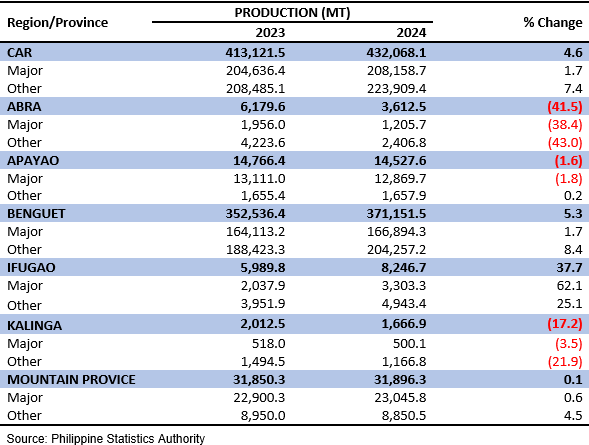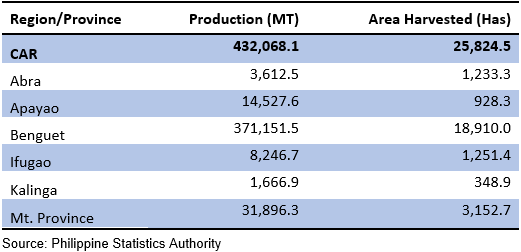
TABLE 1. Major and Other Vegetable Production in CAR by Province: 2023-2024

The total vegetables production of the Cordillera Administrative Region (CAR) increased by 4.6% from 413,121.5MT in 2023 to 432,068.1 MT in 2024. Benguet, Ifugao and Mountain Province registered increases while Abra, Apayao, and Kalinga posted decreases in production (Table 1).
TABLE 2. Distribution of Total Vegetable Production in CAR by Province: 2024

A total of 223,909.4 MT (51.8%) of the overall regional production of 432,068.1 MT in 2024 came from other vegetables, while 208,158.7 MT (48.2%) came from major vegetables.
Benguet consistently was the top producer, accounting for 85.9% share of the total regional vegetables production with 371,151.5 MT. Mountain Province distantly came second with 7.4% share, followed by Apayao with 3.4% share, Ifugao with 1.9% share, and Abra with 0.8% share, respectively.
With an output of 1,666.9MT, Kalinga produced the smallest output of the region's total vegetables production, accounting for 0.4% share of the total vegetable production (Table 2).
MAJOR VEGETABLE CROPS
Mongo, cabbage, eggplant, tomato, onion, camote, cassava, ampalaya fruit, and tomato are among the major vegetable crops.
In 2024, the region's major vegetables output was 208,158.7 MT, accounting for 48.2% of the region's total vegetables production (Table 3).
TABLE 3: Major Vegetable Production in CAR by Province: 2024

With 166,894.3 MT of produce, Benguet consistently ranked first in major vegetables production, accounting for 80.2% share of the total regional output. This was followed by Mountain Province with 11.1% share, Apayao with 6.2%, Ifugao with 1.6%, Abra with 0.6% share, and Kalinga with the smallest of 0.2% share (Table 3).
TABLE 4: Vegetable Production and Area Harvested in CAR by Province: 2024

The total vegetable production of Cordillera recorded a volume of 432,068.1 MT in 2024, with an estimated harvested area of 25,824.5 hectares. Other vegetables dominated the region's vegetables production, contributing 51.8% of the total vegetables production.
Benguet province produced the most vegetables with 371,151.5 MT, from an estimated area harvested of 18,910.0 hectares. Mountain Province came in second with 31,896.3 MT, from an estimated 3,152.7 hectares area harvested, while Kalinga had the lowest vegetables production in the region with 1,666.9 MT, from an estimated 348.9 hectares area harvested (Table 4).
OTHER VEGETABLE CROPS
Benguet contributed 91.2% to the region's other vegetable crops production. Mountain Province came second with 4.0% share, followed by Ifugao with 2.3% share, Abra with 1.1%, and Apayao with 0.7% share. The province of Kalinga had the least percent share of the other vegetable crops production of the region with 0.5% share (Figure 1).
FIGURE 1: Percentage Distribution of Other Vegetables Production
in CAR by Province: 2024

(SGD)
VILLAFE P. ALIBUYOG
Regional Director
Designation Initial Date
CSS AFRB 27 Mar 2025
SuSS WBM 25 Mar 2025
TECHNICAL NOTES
Crop Production This refers to the quantity produced and harvested for a particular crop during the reference period. It includes those measured but damaged, stolen, given away, consumed, given as harvesters’ share, and reserved. Also included are those productions from “pakyaw” and “contract growers”. On the other hand, excluded are those produced but not harvested for whatever reason/s.
Area Planted This is the actual physical area planted measured in hectares. This generally applies to area reported for permanent crops and multi-harvest temporary crops.
Area Harvested is the actual area which harvests are realized. This excludes crop area totally damaged.
Temporary Crops These are crops which are grown seasonally and with a growing cycle of less than one year and which must be sown and planted again for production after each harvest. Some of these crops grow beyond one year but are eventually uprooted to start another production cycle, e.g., peanut, mongo, cassava, tomato, garlic, onion, cabbage, eggplant, etc.
Major Crops These refer to the top 22 crops, which collectively account for almost 95 percent of the total crop production. These include palay, corn, coconut, sugarcane, banana, pineapple, coffee, mango, tobacco, abaca, potato, mongo, onion, cassava, sweet potato, tomato, ampalaya fruit, cabbage, eggplant, calamansi, rubber, and cacao.
Other Crops are the identified crops, not classified as major crops. These includes the Key Commercial Crops Development Program (KCCDP), High Value Commercial Crops (HVCC) Program and now the Key Commodity Road Maps of the Department of Agriculture, which are being developed because of their industrial and commercial potentials.
Unit of Measure This is the unit used by the operator in measuring his/her produce. It can be the commonly used ‘kilogram’, or other unit such as basket, sack, bundle, kerosene can, red bag, crate, kaing, etc., or an equivalent measurement unit in local dialects.



